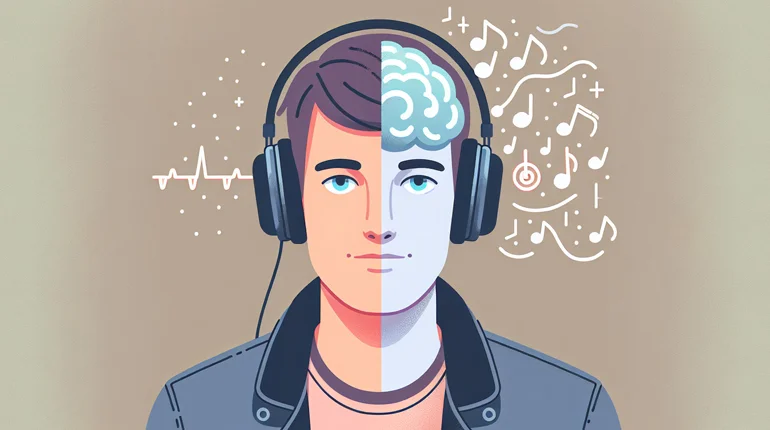Can Binaural Beats Damage Your Brain?

In a world where stress and anxiety are at an all-time high, many are turning to alternative methods for relaxation and focus. Binaural beats, also known as Neurobeats, have emerged as a popular audio tool, promising everything from improved concentration to deeper sleep. But as with any trendy wellness solution, a crucial question arises: Can binaural beats damage your brain? 🧠🎧
This seemingly benign auditory phenomenon has sparked both excitement and apprehension among users and experts. While advocates highlight the benefits of improved cognitive function and reduced stress, skeptics caution against potential risks. As the discussion heats up, it’s crucial to distinguish reality from speculation and grasp the actual influence of binaural beats on our most vital organs.
This comprehensive exploration will delve into the science behind binaural beats, examine potential risks and side effects, debunk common myths, and provide safe usage guidelines. By the end, you’ll clearly understand whether these auditory tools are a groundbreaking solution or a cause for caution. Let’s tune in to the truth about binaural beats and their effects on the brain. 🎵🔍
How Binaural Beats Work?
Binaural beats, an auditory illusion, are created when two slightly different frequencies are played separately into each ear. The brain, with its intricate olivary nucleus, perceives these two frequencies as a single tone pulsing at the difference between the two frequencies. This fascinating phenomenon occurs in the brain’s olivary nucleus, where the two tones are integrated, shedding light on the brain’s anatomy.
For instance, when a 440 Hz tone is played in the left ear and a 444 Hz tone in the right ear, the brain, with its remarkable ability, synthesizes a beat frequency of 4 Hz. This beat, though not physically present in the audio, is a fascinating creation of the brain’s interpretation of the two distinct tones.
The process works as follows:
- Two different frequencies are presented, one to each ear
- The brain processes these frequencies in the olivary nucleus
- The difference between the frequencies is perceived as a rhythmic beat
- This beat is thought to influence brainwave activity
It’s important to note that binaural beats require stereo headphones to be effective, as each ear must receive a different frequency.
Common Uses and Claimed Benefits of Binaural Beats
Binaural beats have gained popularity for their purported ability to influence brain activity and produce various cognitive and physiological effects. While scientific evidence is mixed, proponents claim numerous benefits:
- Improved Focus and Concentration
- Stress Reduction and Relaxation
- Better Sleep Quality
- Enhanced Creativity
- Pain Management
- Meditation Support
- Memory Improvement
- Mood Enhancement
- Athletic Performance
- Habit Formation and Behavior Change
While users widely report these benefits, it’s crucial to approach these claims with a critical mindset. Scientific research on binaural beats is ongoing, and results vary across studies.
| Claimed Benefit
|
Anecdotal Evidence
|
Scientific Support
|
| Improved Focus
|
Strong
|
Moderate
|
| Stress Reduction
|
Strong
|
Moderate to Strong
|
| Better Sleep
|
Strong
|
Moderate
|
| Enhanced Creativity
|
Moderate
|
Limited
|
| Pain Management
|
Moderate
|
Limited
|
| Meditation Support
|
Strong
|
Moderate
|
| Memory Improvement
|
Moderate
|
Limited to Moderate
|
It’s important to note that individual experiences with binaural beats can vary significantly, and what works for one person may not work for another.
What To Consider Before Selecting Binaural Beats?
When selecting binaural beats, consider the following factors:
- Intended Purpose: Choose the frequency range that aligns with your goals (e.g., relaxation, focus, sleep).
- Time of Day: Delta and theta waves may be more suitable for evening use, while beta and gamma might be better for daytime activities.
- Personal Response: Pay attention to how different frequencies affect you individually.
- Duration: Start with shorter sessions (15-30 minutes) and gradually increase as needed.
- Background Sound: Some binaural beats are embedded in nature sounds or music, which may enhance the experience for some users.
Here’s a comparison table of the different types of binaural beats and their potential applications:
| Wave Type
|
Frequency Range
|
Associated State
|
Potential Applications
|
| Delta
|
0.5 – 4 Hz
|
Deep sleep
|
Sleep induction, pain relief, healing
|
| Theta
|
4 – 8 Hz
|
Deep relaxation, light sleep
|
Meditation, creativity, stress reduction
|
| Alpha
|
8 – 13 Hz
|
Relaxed alertness
|
Focus, learning, stress management
|
| Beta
|
13 – 30 Hz
|
Active, alert state
|
Problem-solving, energy boost, concentration
|
| Gamma
|
30 – 100 Hz
|
Peak cognitive performance
|
Memory enhancement, sensory processing
|
Binaural Beats: Potential Risks and Side Effects
Now that we have explored the science behind binaural beats, examining the potential risks and binaural beats side effects associated with their use is crucial. While binaural beats are generally considered safe for most individuals, there are specific considerations and potential adverse effects that users should be aware of.
A. Sleep Disruption
One of the most significant potential risks of using binaural beats is their impact on sleep patterns. While some individuals use binaural beats to improve sleep quality, improper use or overuse can lead to sleep disruption.
How Binaural Beats Affect Sleep?
Binaural beats can influence brainwave patterns, which play a crucial role in sleep cycles. The brain naturally cycles through different brainwave states during sleep:
- Delta waves (0.5-4 Hz): Deep, dreamless sleep
- Theta waves (4-8 Hz): Light sleep and REM (Rapid Eye Movement) sleep
- Alpha waves (8-13 Hz): Relaxed, awake state
Binaural beats designed to induce specific brainwave states can potentially interfere with the natural progression of these sleep cycles.
Potential Sleep-Related Issues
- Difficulty falling asleep: Using high-frequency binaural beats (beta or gamma) close to bedtime can increase alertness and make it harder to fall asleep.
- Interrupted sleep cycles: Listening to binaural beats throughout the night may prevent the brain from naturally transitioning between sleep stages.
- Reduced sleep quality: Overuse of sleep-inducing binaural beats might lead to an overreliance on external stimuli for sleep, potentially reducing the quality of natural sleep.
Recommendations for Safe Use
To minimize the risk of sleep disruption:
- Avoid using binaural beats within 1-2 hours of bedtime
- Limit nighttime sessions to 30 minutes or less
- Use lower frequency beats (delta or theta) for sleep-related purposes
- Allow for natural sleep cycles without continuous binaural beat exposure
B. Cognitive Overload
While binaural beats are often used to enhance cognitive function, there is a potential risk of cognitive overload, especially with prolonged or intense use.
Understanding Cognitive Overload
Cognitive overload occurs when the brain is presented with more information or stimuli than it can effectively process. In the context of binaural beats, this can happen due to:
- Extended listening sessions
- Using frequencies that are too intense or inappropriate for the intended purpose
- Combining binaural beats with other cognitively demanding activities
Symptoms of Cognitive Overload
Users experiencing cognitive overload from binaural beats might notice:
- Difficulty concentrating
- Increased mental fatigue
- Headaches or tension
- Irritability or mood changes
- Decreased performance on cognitive tasks
Mitigating Cognitive Overload Risks
To reduce the risk of cognitive overload:
- Start with shorter listening sessions (10-15 minutes) and gradually increase duration
- Choose appropriate frequencies for your goals (e.g., alpha for relaxation, beta for focus)
- Take regular breaks between sessions
- Avoid multitasking while using binaural beats
- Listen to your body and mind – if you feel overwhelmed, stop the session
C. Interactions with Medical Conditions
Binaural beats can potentially interact with certain medical conditions, making it essential for individuals with pre-existing health issues to exercise caution.
Epilepsy and Seizure Disorders
People with epilepsy or other seizure disorders should be particularly cautious when using binaural beats.
| Concern | Explanation | Recommendation |
| Seizure Trigger | Binaural beats may potentially trigger seizures in susceptible individuals | Consult with a neurologist before using binaural beats |
| Frequency Sensitivity | Certain frequencies may be more likely to provoke seizures | Avoid frequencies known to be problematic for epilepsy (usually in the 15-25 Hz range) |
| Duration of Exposure | Prolonged exposure may increase seizure risk | Limit session duration and frequency if approved by a medical professional |
Conclusion
Binaural beats have gained popularity as a potential tool for enhancing cognitive function and promoting relaxation. While scientific evidence supporting their effectiveness is limited, research suggests that binaural beats are generally safe for most individuals when used appropriately. However, it is crucial to approach their usage with caution and awareness of potential side effects, such as headaches or dizziness, in some users.
To ensure a safe experience with binaural beats, it is recommended that you follow established guidelines, such as using high-quality audio equipment, maintaining moderate volume levels, and limiting listening sessions to reasonable durations.
As with any wellness practice, it is advisable to consult with a healthcare professional before incorporating binaural beats into a routine, especially for individuals with pre-existing medical conditions or those taking medications. By staying informed and using binaural beats responsibly, listeners can explore their potential benefits while minimizing associated risks.

Ekua is an online content editor for ModafinilHack currently. Before joining our team, she was a senior editor for The Walt Disney Company. Earning expertise and editorial experience, she is now contributing her health, nootropics, and psychology knowledge. She’s a graduate of UCLA, where she majored in English.



